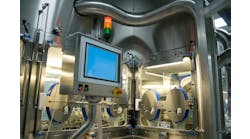Logistics is just one of the strengths that keeps Hong Kong at the center of many companies' strategies for China. That's good news for the former British protectorate because in recent years it has seen nearly 1 million manufacturing jobs move across the border into Mainland China. Its economy is now roughly 86% services, with logistics being one of its major industries and an area targeted for further development.
According to Simon Galpin, associate director general of Invest Hong Kong (www.investhk.gov.hk), 3,600 companies use Hong Kong as a regional base to reach Mainland China and the rest of Asia. That's an all-time high, he points out. A number of factors combine to support this strategy.
Hong Kong's port is one of the largest and most efficient in the world. It handled 24 million twenty-foot-equivalent units (TEUs) in 2004, and though that is only a 7% growth rate, it is good for a mature port, says Janice Tse, deputy secretary for economic development and labor.
The region boasts 18 berths in neighboring ports with 14 million TEUs of capacity, Tse points out. But as trade with Southern China grows, the pie is actually getting bigger. It isn't a zero-sum game, she explains, where one group will lose in proportion to another's gain. In fact, the Hong Kong government is only a facilitator for its port; the various terminal operations are developed and run by private sector companies. Those same companies are developing terminal operations at ports in Southern China's Pearl River Delta.
Hong Kong still anticipates growth for its container port and is working to resolve issues over where to locate Container Terminal 10 and how to improve efficiency of its existing infrastructure (they currently achieve 40-50 container moves per hour). In addition to siting Container Terminal 10, work has begun on the Shenzhen Western Corridor linking Hong Kong's port operations to the Shenzhen Special Economic Zone, where many of the manufacturing plants are located. The development includes a viaduct to expand capacity and shorten transit times on the western route. ( Currently, trucks moving between Shenzhen and the port of Hong Kong move along the congested eastern corridor.)
Improvements aren't limited to physical infrastructure or to motor carriage. Efforts are moving forward to provide river barge operators with multiple entry licenses and lower fees for barges. The western side is better connected by rivers than roads, Tse points out.
Motor carriage has also seen some improvements, says Galpin. The four-upfour-down rule is changing. Chinese regulations require that the driver, tractor, chassis and container move together. This creates some significant inefficiencies because a driver can't drop a chassis and container to be loaded or unloaded while taking another load. Similarly, the driver can't "slip seat" and let another driver complete a move or take a backhaul using the tractor, chassis and container combination.
The first step in liberalizing the rule was to allow the driver to drop a container and pick up another. More efforts are needed to improve motor carrier operations, including adjustment to fees that make Hong Kong drays more expensive than moving the same cargo to another Pearl River Delta port.
Crossing the border between Hong Kong and Shenzhen has also become more fluid. Warren Bishop of Hong Kong Air Cargo Terminal Ltd. (HACTL) (www.hactl.com.hk) points out that 90% of Pearl River Delta cargo goes through Hong Kong. Even with continued development at Mainland Chinese ports and airports in Southern China, Hong Kong will remain a dominant logistics center.
During peak times, Hong Kong's Chek Lap Kok airport can see as many as 40 freighters a day and handle 8,000 tonnes of cargo per day. Where Hong Kong airport handles 3.1 million tonnes of freight per year, the region's other major airport in Guangzhou handles 100,000 tonnes. Guangzhou, Shenzhen and other Southern China airports will grow, Bishop continues, but Hong Kong will maintain its position because it has the volume and frequency.
If your cargo misses a flight in Guangzhou, it may have to wait, he explains. In Hong Kong, it could be shifted to another flight leaving in, perhaps, 30 minutes. The port enjoys a similar advantage with 400-500 vessel calls per week and 80-90 shipping companies operating in Hong Kong, adds Tse.
Some improvements in customs clearance and other regulations have helped HACTL develop its Superlink service, a bonded, cross-border trucking operation reaching seven inland depots that can be used to consolidate southbound goods faster. The average time to move goods from a factory in Shenzhen to air cargo export in Hong Kong is 26 hours, says Bishop. HACTL wants to compress that to 20 hours.
Technology also plays a role. HACTL has developed its own systems, as have a number of other commercial operators. Hong Kong's government has also invested heavily in supply chain technology, says Tse. It is spending $HK 50 million (nearly $US 6.5 million) on the Digital Trade and Transport Network (DTTN), an open-network translator. The DTTN Trade Link will be available to the whole supply chain, says Tse, and the Hong Kong government is encouraging logistics players to join.
Trade software and logistics execution systems aren't the only developments on the technology front. Modern Terminals' (www.modernterminals.com) Sean Kelly says his group has been piloting security systems that will speed processing of export ocean containers and provide more positive identification of the container and its contents. Every container entering the terminal operation passes through a set of technologies that provide a fingerprint of the container — an electronic signature — that can be compared with various target profiles and also with a similar scan at destination to pinpoint any changes in the signature. Far from stopping the containers for inspection, they can be scanned while moving at 15 kilometers per hour (nearly 10 miles per hour).
The Chinese Central Government and Hong Kong have formed an agreement, the Closer Economic Partnership Arrangement (CEPA), to make it easier for the region to develop together. Hong Kong, as an economic center with access to a common-law legal system, major port and airport facilities, trade services and a highly skilled service workforce, can continue to provide a base for companies that want to take advantage of the lower labor costs in the Pearl River Delta and, eventually, access to the growing Chinese domestic market.
With five airports and 18 ocean terminal operations, the region has significant capacity in place. Hong Kong's airport is expected to triple capacity, while the area ports will nearly double operations to 32 terminals by 2012. With somewhere between 17 million and 20 million people in Hong Kong and Shenzhen Special Economic Zone, a cooperative approach could continue to fuel the growth engine for the area. If the attitude is less than cooperative or if policy changes stall, growth will likely continue, but perhaps at a slower pace.


